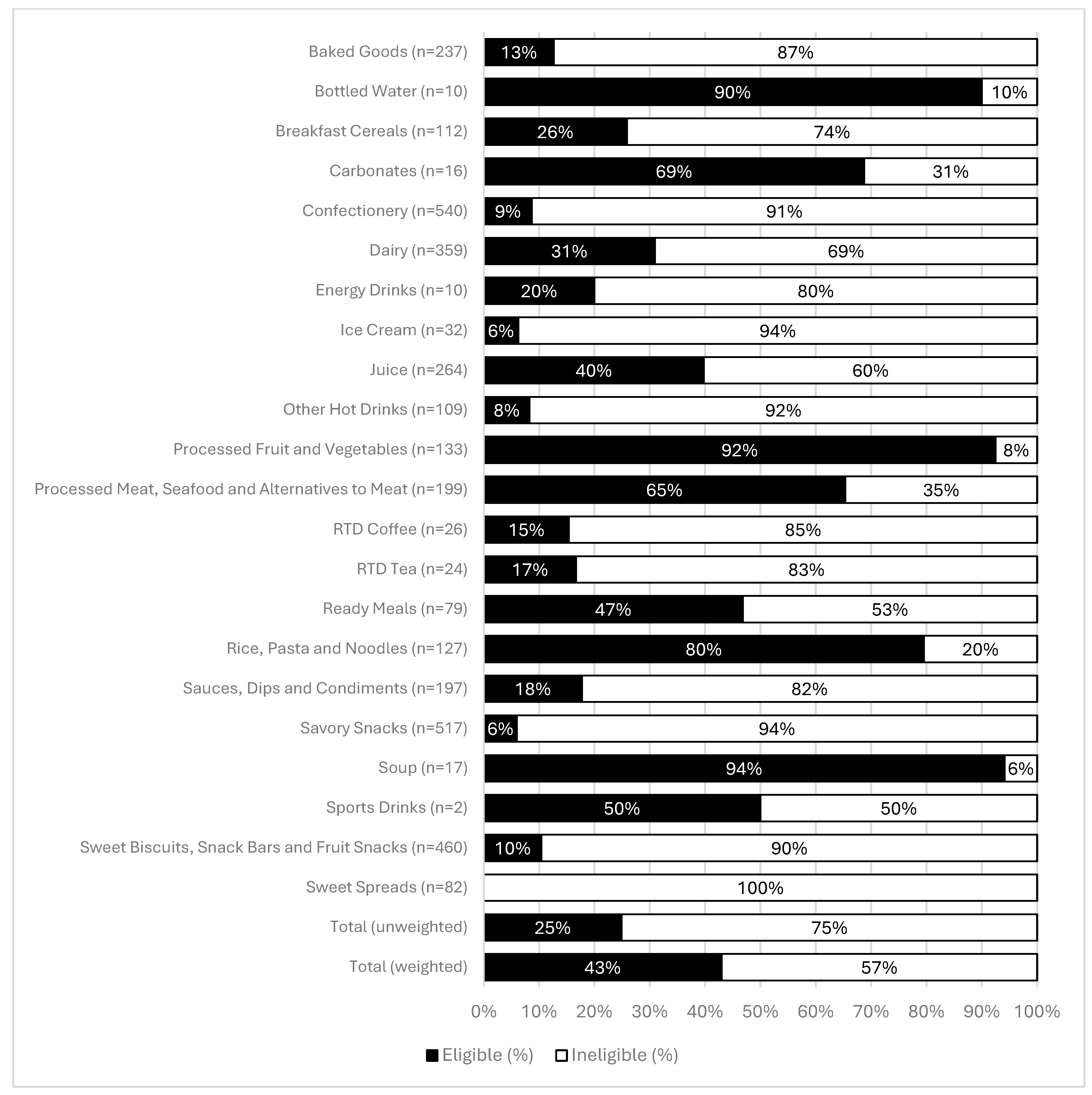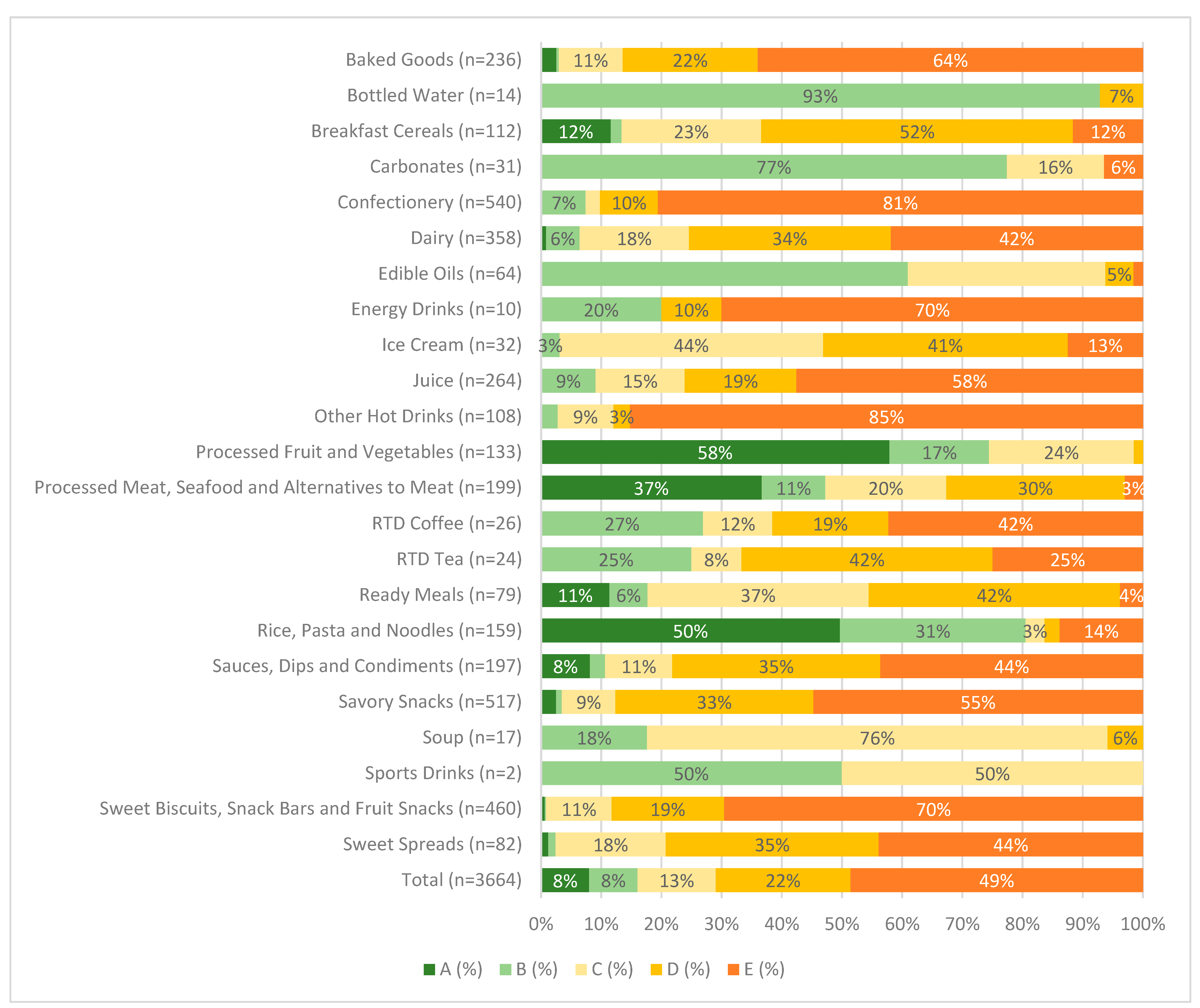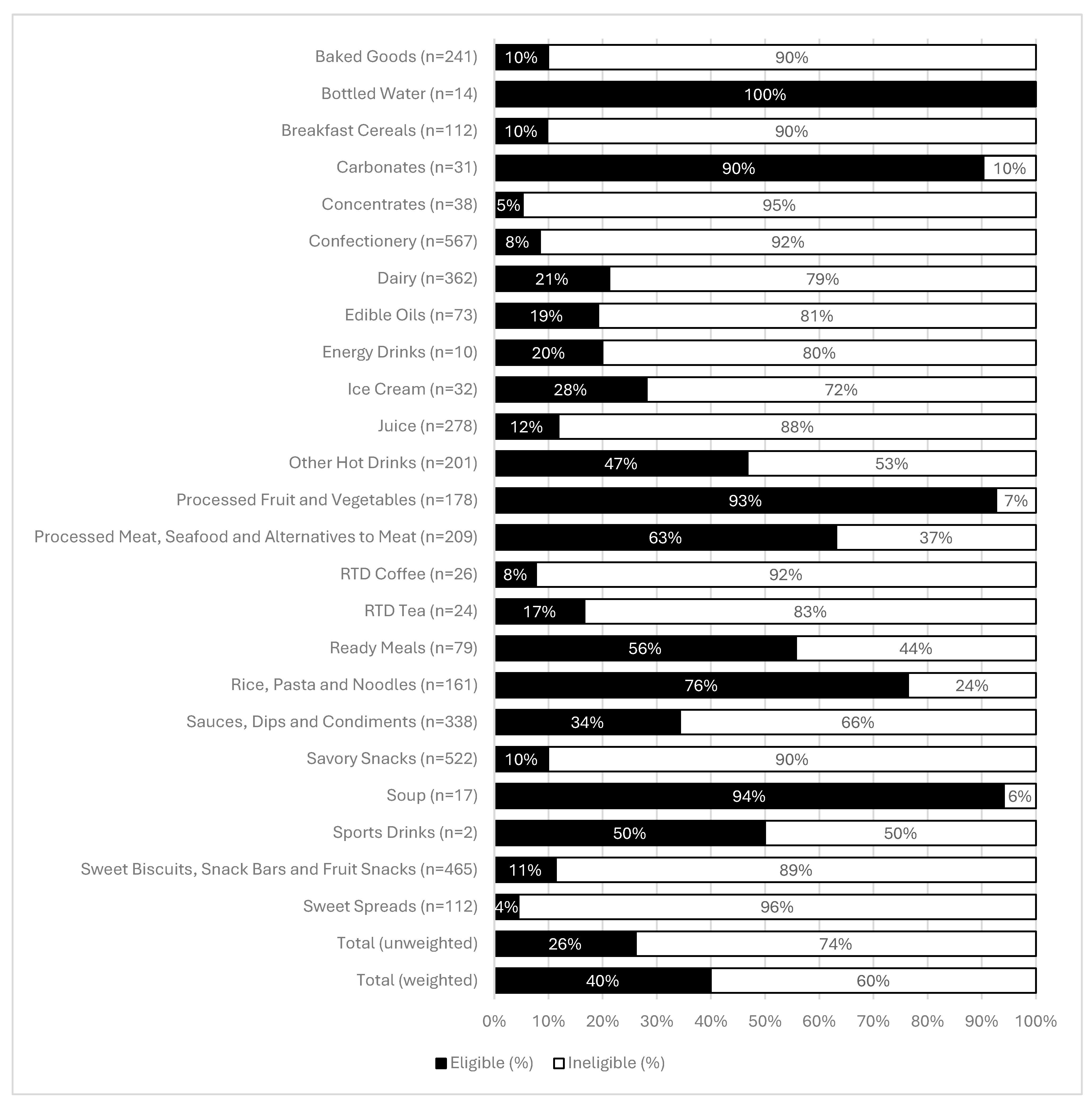The Healthiness of Packaged Food and Beverage Products in the Kingdom of Saudi Arabia
Abstract
1. Introduction
2. Materials and Methods
3. Results
3.1. Saudi Arabian Nutrient Profile Model
3.2. Nutri-Score
3.3. Chile’s HFSS Nutrient Profiling Model (Phase 2)
3.4. Agreement Among the Three Nutrient Profile Models
4. Discussion
5. Conclusions
Supplementary Materials
Author Contributions
Funding
Institutional Review Board Statement
Informed Consent Statement
Data Availability Statement
Acknowledgments
Conflicts of Interest
References
- Aboul-Enein, B.H.; Bernstein, J.; Neary, A.C. Dietary transition and obesity in selected Arabicspeaking countries: A review of the current evidence. East Mediterr. Health J. 2017, 22, 763–770. [Google Scholar] [CrossRef] [PubMed]
- Al-Hazzaa, H.M. Physical inactivity in Saudi Arabia revisited: A systematic review of inactivity prevalence and perceived barriers to active living. Int. J. Health Sci. 2018, 12, 50–64. [Google Scholar]
- Popkin, B.M. Global nutrition dynamics: The world is shifting rapidly toward a diet linked with noncommunicable diseases. Am. J. Clin. Nutr. 2006, 84, 289–298. [Google Scholar] [CrossRef] [PubMed]
- GBD 2017 Saudi Arabia Collaborators. The burden of disease in Saudi Arabia 1990–2017: Results from the Global Burden of Disease Study 2017. Lancet Planet Health 2020, 4, e195–e208. [Google Scholar] [CrossRef] [PubMed]
- World Health Organization. Global Status Report on Noncommunicable Diseases 2014; World Health Organization: Geneva, Switzerland, 2014. [Google Scholar]
- GBD 2017 Risk Factor Collaborators. Global, regional, and national comparative risk assessment of 84 behavioural, environmental and occupational, and metabolic risks or clusters of risks for 195 countries and territories, 1990–2017: A systematic analysis for the Global Burden of Disease Study 2017. Lancet 2018, 392, 1923–1994. [Google Scholar] [CrossRef]
- Stuckler, D.; McKee, M.; Ebrahim, S.; Basu, S. Manufacturing epidemics: The role of global producers in increased consumption of unhealthy commodities including processed foods, alcohol, and tobacco. PLoS Med. 2012, 9, e1001235. [Google Scholar] [CrossRef] [PubMed]
- World Health Organization. Diet, Nutrition and the Prevention of Chronic Diseases: Report of a Joint WHO/FAO Expert Consultation; World Health Organization: Geneva, Switzerland, 2002. [Google Scholar]
- World Health Organization. Nutrient Profiling: Report of a Technical Meeting; World Health Organization: Geneva, Switzerland, 2010. [Google Scholar]
- Labonté, M.; Poon, T.; Gladanac, B.; Ahmed, M.; Franco-Arellano, B.; Rayner, M.; L’Abbé, M.R. Nutrient Profile Models with Applications in Government-Led Nutrition Policies Aimed at Health Promotion and Noncommunicable Disease Prevention: A Systematic Review. Adv. Nutr. 2018, 9, 741–788. [Google Scholar] [CrossRef] [PubMed]
- Choices International. Choices Programme. Available online: https://www.choicesprogramme.org/ (accessed on 10 April 2024).
- Ministerio de Salud; Subsecretaría de Salud Pública. Ley 20606, Reglamento, Evaluación. 2016. Available online: https://www.bcn.cl/leychile/navegar?idNorma=1041570 (accessed on 5 June 2021).
- Merz, B.; Temme, E.; Alexiou, H.; Beulens, J.W.J.; Buyken, A.E.; Bohn, T.; Ducrot, P.; Falquet, M.N.; Solano, M.G.; Haidar, H.; et al. Nutri-Score 2023 update. Nat. Food 2024, 5, 102–110. [Google Scholar] [CrossRef] [PubMed]
- Department of Health. Nutrient Profiling Technical Guidance. 2011. Available online: https://assets.publishing.service.gov.uk/media/5a7cdac7e5274a2c9a484867/dh_123492.pdf (accessed on 10 January 2025).
- Mintel. Mintel Global New Products Database. Available online: https://www.mintel.com/products/gnpd/ (accessed on 14 April 2025).
- Euromonitor Passport. Online Database. 2022. Available online: https://www.euromonitor.com/solutions/passport (accessed on 4 April 2025).
- National Nutrition Committee. Nutrient Profiling Model for the Kingdom of Saudi Arabia. 2020. Available online: https://www.sfda.gov.sa/en/solids-nutrient-calculator (accessed on 10 April 2025).
- Dickie, S.; Woods, J.; Machado, P.; Lawrence, M. Nutrition Classification Schemes for Informing Nutrition Policy in Australia: Nutrient-Based, Food-Based, or Dietary-Based? Curr. Dev. Nutr. 2022, 6, nzac112. [Google Scholar] [CrossRef] [PubMed]
- Dunford, E.K.; Ng, S.W.; Taillie, L.S. How Does the Healthfulness of the US Food Supply Compare to International Guidelines for Marketing to Children and Adolescents? Matern. Child Health J. 2019, 23, 768–776. [Google Scholar] [CrossRef] [PubMed]
- Szabo de Edelenyi, F.; Egnell, M.; Galan, P.; Druesne-Pecollo, N.; Hercberg, S.; Julia, C. Ability of the Nutri-Score front-of-pack nutrition label to discriminate the nutritional quality of foods in the German food market and consistency with nutritional recommendations. Arch. Public Health 2019, 77, 28. [Google Scholar] [CrossRef] [PubMed]
- Shin, S.; Alqunaibet, A.M.; Alsukait, R.F.; Alruwaily, A.; Alfawaz, R.A.; Algwizani, A.; Herbst, C.H.; Shekar, M.; Finkelstein, E.A. A Randomized Controlled Study to Test Front-of-Pack (FOP) Nutrition Labels in the Kingdom of Saudi Arabia. Nutrients 2023, 15, 2904. [Google Scholar] [CrossRef] [PubMed]
- Alhusseini, N.; Ramadan, M.; Aljarayhi, S.; Arnous, W.; Abdelaal, M.; Dababo, H.; Dalati, B.; Doumani, O.A.; AlNasser, S.; Saleem, R. Added sugar intake among the saudi population. PLoS ONE 2023, 18, e0291136. [Google Scholar] [CrossRef] [PubMed]
- Mumena, W.A.; Kutbi, H.A. Sources of free sugar in the diet of Saudi children. Front. Public Health 2024, 12, 1305364. [Google Scholar] [CrossRef] [PubMed]
- Almutairi, L.A.; Althumiri, N.A.; Aljadani, R.H.; Alkhamis, D.; Almarshad, A.; Abanmy, A.; Alhazmi, M.; Aldhewalia, M.; Almubark, R.; Alqahtani, A.S.; et al. Consumer Behavior at Supermarkets during Grocery Shopping in Saudi Arabia: A National Observational Study. Nutr. Health 2022, 28, 19–23. [Google Scholar] [CrossRef] [PubMed]
- Almughthim, A.M.; Jradi, H.A. Nutritional quality of prepackaged foods carrying health or nutritional claims in KSA. J. Taibah. Univ. Med. Sci. 2023, 18, 587–594. [Google Scholar] [CrossRef] [PubMed]
- Alluhidan, M.; Alsukait, R.; Alghaith, T.; Alazemi, N.; Shekar, M.; Herbst, C. Overweight and Obesity in Saudi Arabia: Consequences and Solutions; World Bank: Washington, DC, USA, 2022. [Google Scholar]



| Category | Saudi Arabia NPM | Nutri-Score | Chile HFSS | All 3 NPMs |
|---|---|---|---|---|
| Baked Goods | 237 | 236 | 241 | 236 |
| Bottled Water | 10 | 14 | 14 | 10 |
| Breakfast Cereals | 112 | 112 | 112 | 112 |
| Carbonates | 16 | 31 | 31 | 16 |
| Concentrates | - | - | 38 | - |
| Confectionery | 540 | 540 | 567 | 540 |
| Dairy | 359 | 358 | 362 | 358 |
| Edible Oils | - | 64 | 73 | - |
| Energy Drinks | 10 | 10 | 10 | 10 |
| Ice Cream | 32 | 32 | 32 | 32 |
| Juice | 264 | 264 | 278 | 264 |
| Other Hot Drinks | 109 | 108 | 201 | 108 |
| Processed Fruit and Vegetables | 133 | 133 | 178 | 133 |
| Processed Meat, Seafood and Alternatives | 199 | 199 | 209 | 199 |
| Ready-To-Drink Coffee | 26 | 26 | 26 | 26 |
| Ready-To-Drink Tea | 24 | 24 | 24 | 24 |
| Ready Meals | 79 | 79 | 79 | 79 |
| Rice, Pasta and Noodles | 127 | 159 | 161 | 126 |
| Sauces, Dips and Condiments | 197 | 197 | 338 | 197 |
| Savory Snacks | 517 | 517 | 522 | 517 |
| Soup | 17 | 17 | 17 | 17 |
| Sports Drinks | 2 | 2 | 2 | 2 |
| Sweet Biscuits, Snack Bars and Fruit Snacks | 460 | 460 | 465 | 460 |
| Sweet Spreads | 82 | 82 | 112 | 82 |
| Total | 3552 | 3664 | 4092 | 3548 |
| Category | Total n | Saudi Arabia NPM | Nutri-Score | Chile HFSS | % Agreement | Fleiss’ Kappa |
|---|---|---|---|---|---|---|
| Baked Goods | 236 | 13% | 14% | 10% | 92% | 0.76 |
| Bottled Water | 10 | 90% | 90% | 100% | 90% | 0.46 |
| Breakfast Cereals | 112 | 26% | 37% | 10% | 72% | 0.50 |
| Carbonates | 16 | 69% | 94% | 88% | 75% | 0.40 |
| Confectionery | 540 | 9% | 10% | 9% | 99% | 0.94 |
| Dairy | 358 | 31% | 25% | 22% | 73% | 0.54 |
| Energy Drinks | 10 | 20% | 20% | 20% | 100% | 1.00 |
| Ice Cream | 32 | 6% | 47% | 28% | 56% | 0.26 |
| Juice | 264 | 40% | 24% | 13% | 63% | 0.35 |
| Other Hot Drinks | 108 | 8% | 12% | 6% | 91% | 0.62 |
| Processed Fruit and Vegetables | 133 | 92% | 98% | 91% | 87% | 0.25 |
| Processed Meat, Seafood and Alternatives | 199 | 65% | 67% | 63% | 81% | 0.72 |
| RTD Coffee | 26 | 15% | 38% | 8% | 69% | 0.37 |
| RTD Tea | 24 | 17% | 33% | 17% | 83% | 0.68 |
| Ready Meals | 79 | 47% | 54% | 56% | 76% | 0.68 |
| Rice, Pasta and Noodles | 126 | 80% | 79% | 71% | 89% | 0.79 |
| Sauces, Dips and Condiments | 197 | 18% | 22% | 14% | 89% | 0.76 |
| Savory Snacks | 517 | 6% | 12% | 10% | 85% | 0.41 |
| Soup | 17 | 94% | 94% | 94% | 100% | 1.00 |
| Sports Drinks | 2 | 50% | 100% | 50% | 50% | 0.25 |
| Sweet Biscuits, Snack Bars and Fruit Snacks | 460 | 10% | 12% | 11% | 97% | 0.89 |
| Sweet Spreads | 82 | 0% | 21% | 0% | 79% | −0.07 |
| Total | 3548 | 25% | 27% | 22% | 86% | 0.74 |
Disclaimer/Publisher’s Note: The statements, opinions and data contained in all publications are solely those of the individual author(s) and contributor(s) and not of MDPI and/or the editor(s). MDPI and/or the editor(s) disclaim responsibility for any injury to people or property resulting from any ideas, methods, instructions or products referred to in the content. |
© 2025 by the authors. Licensee MDPI, Basel, Switzerland. This article is an open access article distributed under the terms and conditions of the Creative Commons Attribution (CC BY) license (https://creativecommons.org/licenses/by/4.0/).
Share and Cite
Dunford, E.K.; Alsukait, R.F.; Alkhalaf, M.M.; Hamza, M.M.; Shahin, M.A.; Cetinkaya, V.; Alghaith, T. The Healthiness of Packaged Food and Beverage Products in the Kingdom of Saudi Arabia. Nutrients 2025, 17, 1895. https://doi.org/10.3390/nu17111895
Dunford EK, Alsukait RF, Alkhalaf MM, Hamza MM, Shahin MA, Cetinkaya V, Alghaith T. The Healthiness of Packaged Food and Beverage Products in the Kingdom of Saudi Arabia. Nutrients. 2025; 17(11):1895. https://doi.org/10.3390/nu17111895
Chicago/Turabian StyleDunford, Elizabeth K., Reem F. Alsukait, Majid M. Alkhalaf, Mariam M. Hamza, Mohammed A. Shahin, Volkan Cetinkaya, and Taghreed Alghaith. 2025. "The Healthiness of Packaged Food and Beverage Products in the Kingdom of Saudi Arabia" Nutrients 17, no. 11: 1895. https://doi.org/10.3390/nu17111895
APA StyleDunford, E. K., Alsukait, R. F., Alkhalaf, M. M., Hamza, M. M., Shahin, M. A., Cetinkaya, V., & Alghaith, T. (2025). The Healthiness of Packaged Food and Beverage Products in the Kingdom of Saudi Arabia. Nutrients, 17(11), 1895. https://doi.org/10.3390/nu17111895





